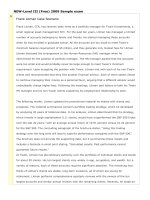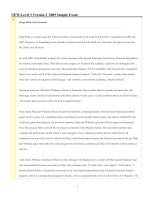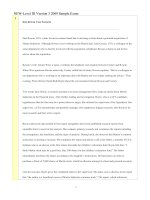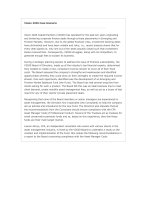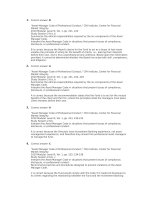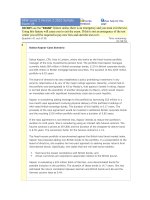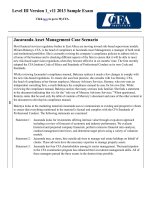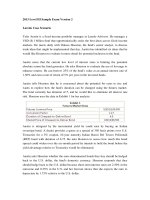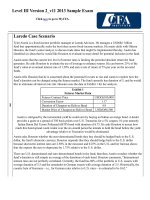2009 l3 sample exam v3 qa
Bạn đang xem bản rút gọn của tài liệu. Xem và tải ngay bản đầy đủ của tài liệu tại đây (188.74 KB, 23 trang )
NEW-Level III Version 3 2009 Sample Exam
1
Don Rowan Case Scenario
Don Rowan, CFA, works for an investment bank that is advising a client about a potential acquisition of Martin
Industries. Although Rowan is not working on the Martin deal, Julia Carney, CFA, a colleague in the same
department who is directly involved with the acquisition, telephones Rowan at home to ask for his advice about
the acquisition.
Rowan’s wife, Joanne West, a nurse, overhears the telephone conversation between Carney and Rowan. When
West questions Rowan about why Carney called him at home, Rowan explains, “She is a colleague in my
department who is working on an important deal with Martin and was simply seeking my advice.” That
evening, West tells her friend Ruth Boyle about the conversation between Rowan and Carney.
Two weeks later, Boyle, a research assistant at an asset management firm, reads an article about Martin
Industries in the financial press. After further reading and investigation, Boyle, who is a CFA candidate,
hypothesizes that the firm may be a prime takeover target. She informs her supervisor of her hypothesis. Her
supervisor, a CFA charterholder and portfolio manager who emphasizes diligent research, tells Boyle to do
more research and then write a report.
Boyle collects the data needed for her report and gathers previously published research reports from reputable
firms to assist in her analysis. She conducts primary research and scrutinizes the reports including the
assumptions, the timeliness, and the rigor of analysis. During lunch, she observes that Martin’s common stock
price is starting to increase. She completes her report and places a call to her father, a member of CFA Institute
who is an advisor at the firm where she holds her children’s education fund. Boyle tells him, “I think Martin
stock may be a good buy. Buy 300 shares for the children’s education fund.” Her father immediately purchases
the shares according to his daughter’s instructions. He then places an order to purchase a block of 5,000 shares
of Martin stock, which he allocates among his client and personal accounts.
Late the next day, Boyle gives her completed report to her supervisor. She takes care to disclose in the report
that “the author is a beneficial owner of Martin Industries common stock.” The report, which references
1
previously published reports as Boyle’s main sources, recommends purchase of Martin stock for investors with
above-average risk tolerance. The supervisor reads the report immediately and is impressed with Boyle’s work.
He questions Boyle about her research, her sources, and her recommendation. Satisfied with Boyle’s responses,
he places an order to purchase a block of 25,000 shares to be allocated among his clients.
Question 1
When disclosing the Martin Industries deal to Rowan, did Carney violate any CFA Institute Standards of Professional
Conduct?
A. No.
B. Yes, relating only to client confidentiality.
C. Yes, relating to both client confidentiality and fiduciary duty to employer.
Correct Answer = A
"Guidance" for Standards I — VII, CFA Institute
2009 Modular Level III, Vol. 1, pp. 67-71
Study Session 1-2-a
Demonstrate a thorough knowledge of the Code of Ethics and Standards of Professional Conduct by interpreting the
Code and Standards in various situations involving issues of professional integrity.
According to Standard III (E), Duties to Clients: Preservation of Confidentiality, members may disclose information
received from clients to fellow employees in an effort to improve client service. The Standard relating to Duties to
Employers does not include a fiduciary duty.
2
When disclosing Carney's involvement in the Martin Industries deal to West, did Rowan violate any CFA Institute
Standards?
A. No.
B. Yes, only the Standard relating to client confidentiality.
C. Yes, the Standards relating to client confidentiality and to fiduciary duty to employer.
Correct Answer = B
"Guidance" for Standards I — VII, CFA Institute
2
2009 Modular Level III, Vol. 1, pp. 67-68
Study Session 1-2-a
Demonstrate a thorough knowledge of the Code of Ethics and Standards of Professional Conduct by interpreting the
Code and Standards in various situations involving issues of professional integrity.
Standard III (E) Duties to Clients: Preservation of Confidentiality, requires that members preserve the confidentiality
of information communicated to them by their clients. The Standard relating to Duties to Employers does not include a
fiduciary duty.
3
When buying Martin Industries stock for her children's education fund, did Boyle violate any CFA Institute Standards?
A. No.
B. Yes, relating to priority of transactions.
C. Yes, relating to material nonpublic information.
Correct Answer = B
"Guidance" for Standards I — VII, CFA Institute
2009 Modular Level III, Vol. 1, pp. 94-95
Study Session 1-2-a
Demonstrate a thorough knowledge of the Code of Ethics and Standards of Professional Conduct by interpreting the
Code and Standards in various situations involving issues of professional integrity.
According to Standard VI (B), Conflicts of Interest: Priority of Transactions, members may undertake transactions in
accounts for which they are a beneficial owner only after their clients and employers have had adequate opportunity to
act.
4
With respect to the block trade in Martin Industries stock, did Boyle's father violate any CFA Institute Standards?
A. No.
B. Yes, relating only to reasonable basis.
C. Yes, relating to both reasonable basis and material nonpublic information.
Correct Answer = B
"Guidance" for Standards I — VII, CFA Institute
2009 Modular Level III, Vol. 1, pp. 80-81
"Pearl Investment Management (A), (B), and (C)," Glen Holdern, Jr., CFA
2009 Modular Level III, Vol. 1, p. 197
Study Sessions 1-2-a, 2-5-a
Demonstrate a thorough knowledge of the Code of Ethics and Standards of Professional Conduct by interpreting the
Code and Standards in various situations involving issues of professional integrity.
3
Evaluate professional conduct and formulate an appropriate response to actions that violate the CFA Institute Code of
Ethics and Standards of Professional Conduct.
According to Standard V (A), Investment Analysis, Recommendations, and Action: Diligence and Reasonable Basis,
members must exercise diligence, independence, and thoroughness in analyzing investments, making investment
recommendations, and taking investment actions. They must have a reasonable and adequate basis, supported by
appropriate research and investigation for any investment action. Boyle did not have a reasonable and adequate basis,
supported by appropriate research and investigation for his block purchase.
5
When completing and submitting her report on Martin Industries, did Boyle violate any CFA Institute Standards?
A. No.
B. Yes, because she did not disclose the amount of her beneficial ownership.
C. Yes, because she did not attempt to disseminate the material nonpublic information.
Correct Answer = A
"Guidance" for Standards I — VII, CFA Institute
2009 Modular Level III, Vol. 1, pp. 24-25, 38-39, 80-81, 89-91
"Pearl Investment Management (A), (B), and (C)," Glen Holdern, Jr., CFA
2009 Modular Level III, Vol. 1, pp. 195-198
Study Sessions 1-2-a, 2-5-a
Demonstrate a thorough knowledge of the Code of Ethics and Standards of Professional Conduct by interpreting the
Code and Standards in various situations involving issues of professional integrity.
Evaluate professional conduct and formulate an appropriate response to actions that violate the CFA Institute Code of
Ethics and Standards of Professional Conduct.
Boyle did not commit a violation. By disclosing that she was beneficial owner of Martin stock, she alerted readers that
her recommendation may be biased. Including other people's work is not a violation if it is referenced, as it was by
Boyle. Boyle's report was based on the Mosaic Theory and she was free to act on the collection of material.
6
When trading in Martin Industries stock, did Boyle's supervisor violate any CFA Institute Standards?
A. No.
B. Yes, because he was trading on material nonpublic information.
C. Yes, because he purchased a single block rather than purchasing shares for individual client
accounts.
Correct Answer = A
"Guidance" for Standards I — VII, CFA Institute
2009 Modular Level III, Vol. 1, pp. 38-39, 53, 80-81
4
"Pearl Investment Management (A), (B), and (C)," Glen Holdern, Jr., CFA
2009 Modular Level III, Vol. 1, pp. 191-198
Study Sessions 1-2-a, 2-5-a
Demonstrate a thorough knowledge of the Code of Ethics and Standards of Professional Conduct by interpreting
the Code and Standards in various situations involving issues of professional integrity.
Evaluate professional conduct and formulate an appropriate response to actions that violate the CFA Institute Code
of Ethics and Standards of Professional Conduct.
Boyle's supervisor did not commit a violation. The new research report provided a reasonable basis for his
investment decision. He did not possess material nonpublic information. Fair dealing allows a single block
purchase to be allocated among individual accounts.
7
Bobby Sarkar Case Scenario
Bobby Sarkar, Chief Investment Officer for the Daniels Corporation pension plan, is meeting with the
Investment Policy Committee to evaluate portfolio managers for the pension fund.
To help with the evaluation Sarkar has collected information on three active portfolio managers. This
information is presented below in Exhibit 1 and Exhibit 2.
Exhibit 1
Investment Manager Data
December 31, 2007
Manager
Manager
Manager
A
B
C
2876
3752
4619
8.7
17.5
23.1
Dividend yield
3.50%
1.70%
1.00%
EPS growth (5-year projected)
6.75%
5.25%
14.50%
Portfolio active return
3.50%
3.00%
4.30%
Portfolio tracking risk
5.00%
1.50%
6.00%
Style fit
87.00%
95.00%
85.00%
Assets under management ($ millions)
P/E
Exhibit 2
Returns-Based Style Analysis
5
December 31, 2007
Style Index
Weights
Manager
Manager
Manager
A
B
C
Russell 1000 Value Index
58%
0%
4%
Russell 1000 Growth Index
4%
0%
28%
Russell 2000 Value Index
35%
50%
3%
Russell 2000 Growth Index
3%
50%
65%
100%
100%
100%
The Russell 1000 indexes consist of large capitalization stocks, while the Russell 2000 indexes consist
of small capitalization stocks.
Reena Hashmi, one of the members of the investment policy committee, makes the following statement,
"I think it would be cheaper to use a passive investment strategy instead of using active portfolio
managers."
Question
Based on the information presented in Exhibits 1 and 2, manager A is most likely following a:
A. value investment strategy.
B. growth investment strategy.
C. semi-active investment strategy.
Correct Answer = A
"Equity Portfolio Management," Gary L. Gastineau, Andrew R. Olma, and Robert G. Zielinski
2009 Modular Level III, Vol. 4, pp. 179-181, 206-215
Study Session 11-33-b, i
Discuss the rationales for passive, active, and semi-active (enhanced index) equity investment approaches and
distinguish among those approaches with respect to expected active return and tracking risk.
Compare and contrast techniques for identifying investment styles and characterize the style of an investor
when given a description of the investor's security selection method, details on the investor's security holdings,
6
or the results of a returns-based style analysis.
Manager A has a low P/E, high dividend yield and a style fit of 87%, which suggests that he is following an
active value strategy. Furthermore, Exhibit 2 shows that he is following a value strategy, 58% weight on the
Russell 1000 value index, and 35% weight on the Russell 2000 value index. The weights on the other two
growth indexes are minimal.
8
Based on the information presented in Exhibits 1 and 2, manager B is most likely following a:
A. value investment strategy.
B. growth investment strategy.
C. semi-active investment strategy.
Correct Answer = C
"Equity Portfolio Management," Gary L. Gastineau, Andrew R. Olma, and Robert G. Zielinski
2009 Modular Level III, Vol. 4, pp. 179-181, 206-215
Study Session 11-33-b, i
Discuss the rationales for passive, active, and semi-active (enhanced index) equity investment approaches and
distinguish among those approaches with respect to expected active return and tracking risk.
Compare and contrast techniques for identifying investment styles and characterize the style of an investor when given
a description of the investor's security selection method, details on the investor's security holdings, or the results of a
returns-based style analysis.
The data in Exhibits 1 and 2 indicate that manager B has no clear value or growth bias. However, manager B has the
lowest overall tracking risk, which is a feature of semi-active managers. Also note that the style fit is 95% compared to
87% for manager A and 85% for manager B, both of whom are active managers.
9
Based on the information presented in Exhibits 1 and 2, manager C is most likely following a:
A. value investment strategy.
B. growth investment strategy.
C. semi-active investment strategy.
Feedback: You have answered incorrectly.
Correct Answer = B
"Equity Portfolio Management," Gary L. Gastineau, Andrew R. Olma, and Robert G. Zielinski
2009 Modular Level III, Vol. 4, pp. 179-181, 206-215
Study Session 11-33-b, i
Discuss the rationales for passive, active, and semi-active (enhanced index) equity investment approaches and
7
distinguish among those approaches with respect to expected active return and tracking risk.
Compare and contrast techniques for identifying investment styles and characterize the style of an investor when given
a description of the investor's security selection method, details on the investor's security holdings, or the results of a
returns-based style analysis.
Manager C has a high P/E, low dividend yield, high EPS growth and a style fit of 85%, which suggests that he is
following an active growth strategy. Furthermore, Exhibit 2 shows that he is following a growth strategy, 28% weight
on the Russell 1000 growth index, and 65% weight on the Russell 2000 growth index. The weights on the other two
growth indexes are minimal.
10 A contrarian investing substyle would most likely be used by:
A. manager A.
B. manager B.
C. manager C.
Correct Answer = A
"Equity Portfolio Management," Gary L. Gastineau, Andrew R. Olma, and Robert G. Zielinski
2009 Modular Level III, Vol. 4, pp. 202-203
Study Session 11-33-h
Explain the rationales and primary concerns of value investors and growth investors and discuss the key risks of each
investment style.
Manager A is a value manager and contrarian investing is a value investing substyle. Manager A has a low P/E, high
dividend yield and a style fit of 87%, which suggests that he is following an active value strategy. Furthermore,
Exhibit 2 shows that he is following a value strategy, 58% weight on the Russell 1000 value index, and 35% weight on
the Russell 2000 value index. The weights on the other two growth indexes are minimal.
11 Which of the following managers most likely follows a market oriented style with a small capitalization bias?
A. Manager A.
B. Manager B.
C. Manager C.
Correct Answer = B
"Equity Portfolio Management," Gary L. Gastineau, Andrew R. Olma, and Robert G. Zielinski
2009 Modular Level III, Vol. 4, pp. 200-212
Study Session 11-33-g, h, i
Explain and justify the use of equity investment style classifications and discuss the difficulties in applying style
definitions consistently.
8
Explain the rationales and primary concerns of value investors and growth investors and discuss the key risks of each
investment style.
Compare and contrast techniques for identifying investment styles and characterize the style of an investor when
given a description of the investor's security selection method, details on the investor's security holdings, or the results
of a returns-based style analysis.
Manager B follows a market oriented style with a small cap bias. The data in Exhibits 1 and 2 indicate that manager B
has no clear value or growth bias. However, Exhibit 2 shows weights of 50% each on the Russell 2000 growth and
Russell 2000 value indexes. Both of these indexes are small cap indexes.
12 The investment strategy suggested by Hashmi can be implemented by:
A. equitizing a market neutral portfolio.
B. following a long-short investment strategy.
C. taking a long position in cash and index futures contracts.
Correct Answer = C
"Equity Portfolio Management," Gary L. Gastineau, Andrew R. Olma, and Robert G. Zielinski
2009 Modular Level III, Vol. 4, p. 192
Study Session 11-33-e
Compare and contrast alternative methods for establishing passive exposure to an equity market, including indexed
separate or pooled accounts, index mutual funds, exchange-traded funds, equity index futures, and equity total return
swaps.
One way to implement a passive investment strategy is to take a long position in cash and to take a long position in
index futures contracts.
13
Nabil Shariff Case Scenario
Nabil Shariff is the senior manager for MIR Capital's U.S.-based Global Bond Portfolio. Shariff is meeting
with a junior portfolio manager, Jennifer Eastwood, to discuss strategies to improve performance and manage
the risk exposure of the portfolio. Summary data for the portfolio is presented in Exhibit 1.
Exhibit 1
Summary Information for MIR Capital's Global Bond Portfolio
Country
9
Risk-Free
US$ / Currency
Bond
Country
Weight
Duration
Beta
Return
Spot
Forecast
Yield
U.S.
55%
5.90
--
3.50%
--
--
4.47%
U.K.
20%
5.67
0.80
5.00%
1.84
1.80
6.00%
Euro-Zone
25%
5.50
0.70
4.50%
1.20
1.19
5.50%
Their discussion initially centers on the U.S. component of the portfolio. Commenting on the U.S. interest rate
outlook, Shariff states, "The consensus of economic forecasters is that the yield curve will shift up in the
coming months, with the yields on longer maturities rising by more than those on shorter maturities."
Eastwood responds with the following statements:
Statement 1:
"This will also result in a widening of credit spreads as U.S. companies issue more investment
grade bonds."
Statement 2:
"Given the yield curve outlook, callable bonds will outperform bullet maturities and bullets
will outperform putable bonds."
Shariff concludes the discussion on the U.S. component of the global bond portfolio by asking Eastwood to
report back with a recommendation for an appropriate strategy to moderate portfolio credit risk.
The discussion then turns to the international component of the Global Bond Portfolio. Eastwood asks Shariff:
"Given the data in Exhibit 1, should we hedge our currency risk in the pound or euro?"
At this point Shariff must leave to attend a meeting with MIR Capital's partners, but he indicates that he will
respond to Eastwood after the meeting.
Question 13
Is Eastwood's first statement regarding credit spreads most likely correct?
A. Yes.
B. No; the increased supply of investment grade bonds will cause prices to fall and spreads to
narrow.
10
C. No; the increased supply of investment grade bonds will cause prices to rise and spreads to
narrow.
Correct Answer = C
"Relative-Value Methodologies for Global Credit Bond Portfolio Management," Jack Malvey
2009 Modular Level III, Vol. 4, p. 67
Study Session 9-30-b
Evaluate the portfolio implications of cyclical changes in the primary corporate bond market (such as an increase or
decrease in new issue supply) and secular changes (such as a shift in dominant product structures).
Contrary to the normal supply-price relation where rising supply causes prices to fall and spreads to widen, increased
supply in the investment grade credit market causes spreads to narrow as new issue valuations validate and enhance
secondary market valuations.
14 In Statement 2, is Eastwood most likely correct with regard to the performance of callable bonds and putable bonds,
respectively, compared to bullets?
A. Yes.
B. No, because callable and putable bonds both outperform bullets.
C. No, because callable bonds underperform bullets while putable bonds outperform bullets.
Correct Answer = B
"Relative-Value Methodologies for Global Credit Bond Portfolio Management," Jack Malvey
2009 Modular Level III, Vol. 4, pp. 68, 71, 77-80
Study Session 9-30-d, e
Discuss the primary reasons for secondary market trading, including yield/spread pickup trades, credit-upside trades,
credit-defense trades, new issue swaps, sector-rotation trades, yield curve-adjustment trades, structure trades, and cash
flow reinvestment.
Discuss and evaluate corporate bond portfolio strategies that are based on relative value, including total return
analysis, primary market analysis, liquidity and trading analysis, secondary trading rationales and trading constraints,
spread analysis, structure analysis, credit curve analysis, credit analysis, and asset allocation/sector analysis.
Callable bonds will outperform bullet maturities as the probability of an early call diminishes with rising interest rates.
Putable bonds will outperform bullet maturities because investors can avoid losses associated with rising interest rates
by putting the bond back to the company.
15 When Eastwood responds to Shariff's regarding portfolio credit risk, the most appropriate recommendation is to:
A. reduce the duration of U.S. bond portfolio.
B. invest in shorter maturity Treasuries and longer maturity corporate bonds.
11
C. invest in shorter maturity corporate bonds and longer maturity Treasuries.
Correct Answer = C
"Relative-Value Methodologies for Global Credit Bond Portfolio Management," Jack Malvey
2009 Modular Level III, Vol. 4, pp. 71, 81
Study Session 9-30-d, e
Discuss the primary reasons for secondary market trading, including yield/spread pickup trades, credit-upside trades,
credit-defense trades, new issue swaps, sector-rotation trades, yield curve-adjustment trades, structure trades, and cash
flow reinvestment.
Discuss and evaluate corporate bond portfolio strategies that are based on relative value, including total return
analysis, primary market analysis, liquidity and trading analysis, secondary trading rationales and trading constraints,
spread analysis, structure analysis, credit curve analysis, credit analysis, and asset allocation/sector analysis.
Shariff asked Eastwood to recommend a strategy to moderate credit risk. This may be accomplished with a credit
barbell strategy in which portfolio managers invest in shorter term corporate bonds and less risky Treasury securities
with longer maturities.
16 If bond yields in the U.S. rise by 25 basis points, then the percentage decline in the value of Euro-Zone bonds is
closest to:
A. 0.96%.
B. 1.03%.
C. 1.38%.
Correct Answer = A
"Fixed-Income Portfolio Management — Part II," H. Gifford Fong and Larry D. Guin, CFA
2009 Modular Level III, Vol. 4, pp. 123-124
Study Session 10-31-h
Analyze the change in value for a foreign bond when domestic interest rates change, given the bond's duration and the
country beta, and analyze the contribution of a foreign bond to a domestic portfolio's duration, given the duration of
the foreign bond and the country beta.
Change in value of Euro-Zone bond
= Euro-Zone Duration × Country beta × change in U.S. interest rates
= 5.5 × 0.7 × 0.0025 = 0.009625 = 0.96%
17 Shariff's most appropriate response to Eastwood regarding the hedging of currency risk is to:
A. hedge exposure to euros only.
B. hedge exposure to pounds only.
12
C. hedge exposure to pounds and euros.
Correct Answer = B
"Fixed-Income Portfolio Management — Part II," H. Gifford Fong and Larry D. Guin, CFA
2009 Modular Level III, Vol. 4, pp. 125-129
Study Session 10-31-i
Recommend and justify whether to hedge or not hedge an international bond investment.
The difference between short-term rates in the U.S. and U.K. is: ius — iuk = —1.5%. According to interest rate parity,
this implies that the pound will decline in value by 1.5% relative to the dollar. According to MIR Capital's forecasts,
the pound is expected to decline in value by —2.174% = (1.8 — 1.84) / 1.84. Therefore the exposure to pounds should
be hedged. The situation with the euro is the opposite and it should not be hedged.
18 Over a 1-year horizon, the spread change that will eliminate the yield advantage of Euro-zone bonds over U.S. bonds
is closest to:
A. 0.17%.
B. 0.19%.
C. 0.36%.
Correct Answer = A
"Fixed-Income Portfolio Management — Part II," H. Gifford Fong and Larry D. Guin, CFA
2009 Modular Level III, Vol. 4, pp. 129-130
Study Session 10-31-j
Illustrate how breakeven spread analysis can be used to evaluate the risk in seeking yield advantages across
international bond markets.
The spread change is calculated as follows:
(Euro-zone bond yield — U.S. bond yield) / U.S. duration = (0.055 — 0.0447) / 5.9 = 0.17%.
19
Amy Allison Case Scenario
Amy Allison is a pension fund manager at Downing Securities. The third quarter ends today and she is
preparing for her quarterly review with her five largest U.S.-based clients. To complete her analysis, she has
obtained the market data in Exhibit 1.
Exhibit 1
13
Level of NASDAQ 100 Index
1223.14
Level of FTSE 100 Index
4176.70
Level of S&P 500 Index
984.03
Level of S&P/Barra Growth Index
496.24
Level of S&P/Barra Value Index
484.28
Price of December FTSE 100 futures contract
£41,760
Price of December S&P 500 Index futures contract
$245,750
Price of December S&P/Barra Growth futures contract
$117,475
Price of December S&P/Barra Value futures contract
$120,875
Beta of FTSE 100 futures contract
1.03
Beta of S&P/Barra Growth futures contract
1.15
Beta of S&P/Barra Value futures contract
1.03
Price of December U.S. Treasury-bond futures contract
$106,906
Modified Duration of U.S. Treasury-bond futures contract
6.87
Macaulay Duration of U.S. Treasury-bond futures contract
7.05
Price of December £-Forward Contract ($/£)
1.595
Spot $/£ Exchange Rate
1.603
U.S. Risk-free Rate (90-day)*
0.95%
U.K. Risk-free Rate (90-day) *
2.86%
Long-term U.S. Treasury-bond Yield*
5.10%
Market Data
As of September 30
*annualized rates
Allison's assistant has prepared the following summaries of each client's current situation, including any recent
inquiries or requests from the clients.
14
•
Client A has a $20 million technology equity portfolio. At the beginning of the last quarter, Allison forecasted
a weak equity market and adjusted the risk of the portfolio by lowering the portfolio's beta from 1.20 to 1.05.
To lower the beta, Allison sold 25 December NASDAQ 100 futures contracts at $124,450. During the
quarter, the market decreased by 3.5 percent, the value of the equity portfolio decreased by 5.1 percent, and
the NASDAQ futures price fell from $124,450 to $119,347. Client A has questioned the effectiveness of the
futures transaction used to adjust the portfolio beta.
•
Client B has a $40 million value-stock portfolio with a portfolio beta of 1.06. This client wants to shift $22
million from the value-stock portfolio to a growth-stock portfolio with a target beta of 1.21. Allison will
implement this shift using S&P/Barra Growth and S&P/Barra Value futures contracts.
•
Client C anticipates receiving $75 million in December. This client is optimistic about the near-term
performance of the equity and debt markets and does not want to wait until the money is received to invest it.
The client wants Allison to establish a position that allocates 60 percent of the money to a well-diversified
equity portfolio with a target beta of 1.00 and 40 percent of the money to a long-term debt portfolio with a
target modified duration of 5.75. Allison plans to use the December U.S. Treasury-bond futures to establish
the debt position.
•
Client D has £15 million invested in U.K. equities with a portfolio beta of 0.87 and is concerned about
currency and market risk over the next 90 days. Allison would use the £-forward contract and the December
FTSE 100 futures contract as hedging instruments to manage those risks, respectively. Allison forecasts a
negative return on the U.K. equity market of 4.25 percent, a reduction in the spot $/£ exchange rate to 1.48,
and a decline in the FTSE 100 futures contract price to £38,940 at the expiration of the December contract.
•
Client E has $10 million in cash and is optimistic about the near-term performance of the large-cap stocks in
the U.S. equity market. The client anticipates positive performance for approximately 3 months, at which
time inflation fears will begin to be priced into the market and the large-cap stocks will underperform cash.
Client E asks Allison to implement a strategy that will create profit from this view if it proves to be correct
and can be exited quickly if it proves to be incorrect.
Question 19
With respect to Client A, Allison's most appropriate conclusion is that the futures transaction used to adjust the beta of
the portfolio was:
A. effective.
B. ineffective, because the effective beta on the portfolio was 1.27.
C. ineffective, because the effective beta on the portfolio was 1.64.
Correct Answer = B
15
"Risk Management Applications of Forward and Futures Strategies," Don M. Chance
2009 Modular Level III, Vol. 5, pp. 322-324
Study Session 15-42-a
Demonstrate the use of equity futures contracts to achieve a target beta for a stock portfolio, and calculate and
interpret the number of futures contracts required.
The effective beta is the (hedged) return on the portfolio divided by the return on the market. The return on the market
is —3.5%. The return on the portfolio is —5.1% plus the return on the futures position. The return on the (short)
futures position relative to the unhedged portfolio is —25 × (119,347 — 124,450) / 20,000,000 = + 0.0064. Effective
beta = (—0.051 + 0.0064) / —0.035 = 1.27.
20 When implementing the shift from value to growth for Client B, the number of S&P/Barra value futures contracts that
Allison should short is closest to:
A. 177.
B. 87.
C. 193.
Correct Answer = B
"Risk Management Applications of Forward and Futures Strategies," Don M. Chance
2009 Modular Level III, Vol. 5, pp. 338-341
Study Session 15-42-e
Demonstrate the use of futures to adjust the allocation of a portfolio across equity sectors and to gain exposure to an
asset class in advance of actually committing funds to the asset class.
To convert $22 million of the value-stock portfolio to cash (beta = 0) will require:
To convert the $22 million of cash into growth-stock will require:
21 The number of December U.S. Treasury-bond futures contracts Allison should buy for Client C is closest to:
A. 229.
16
B. 235.
C. 335.
Correct Answer = B
"Risk Management Applications of Forward and Futures Strategies," Don M. Chance
2009 Modular Level III, Vol. 5, pp. 341-344
Study Session 15-42-e
Demonstrate the use of futures to adjust the allocation of a portfolio across equity sectors and to gain exposure to an
asset class in advance of actually committing funds to the asset class.
The number of bond futures required is:
22 Suppose that Client D instructs Allison to hedge 100 percent of the portfolio's U.K. equity market risk, but not its
currency risk. The expected dollar value of the hedged portfolio according to Allison's forecasts is closest to:
A. $15,299,835.
B. $22,643,756.
C. $24,403,237.
Correct Answer = B
"Risk Management Applications of Forward and Futures Strategies," Don M. Chance
2009 Modular Level III, Vol. 5, pp. 348-352
Study Session 15-42-g
Explain the limitations to hedging the exchange rate risk of a foreign market portfolio and discuss two feasible
strategies for managing such risk.
According to Allison's forecasts, the portfolio's value in pounds will be:
(1 + (portfolio beta × market return)) × value of portfolio = (1 + (0.87 × —0.0425)) × £15 million = £14,445,375. The
futures contracts payoff at expiration will be (£38,940 — £41,760) × —303 = £854,460. The total value is
£15,299,835. At the forecasted exchange rate of $1.48/£, the expected dollar value of the portfolio is £15,299,835 ×
$1.48/£ = $22,643,756.
23 Suppose that Client D believes Allison's forecasts are accurate and that her proposed FTSE 100 futures contract
position will fully hedge the portfolio's market risk. If Client D wants to fully hedge currency risk with a £-forward
contract, the notional principal on the contract is closest to:
17
A. £14,893,511.
B. £15,000,000.
C. £15,107,250.
Correct Answer = C
"Risk Management Applications of Forward and Futures Strategies," Don M. Chance
2009 Modular Level III, Vol. 5, pp. 348-352
Study Session 15-42-g
Explain the limitations to hedging the exchange rate risk of a foreign market portfolio and discuss two feasible
strategies for managing such risk.
The fully market-risk hedged stock portfolio should earn the foreign risk-free rate. The forward contract should allow
the client to exchange the expected value of the portfolio into dollars. The appropriate notional principal on the
forward contract = the beginning value × (1 + current U.K. interest rate) = £15,000,000 × (1 + (0.0286 / 4) =
£15,107,250.
24 In order to implement the request from Client E, Allison's most appropriate course of action is to:
A. purchase risk-free bonds and sell S&P 500 index futures contracts.
B. PUrchase risk-free bonds and buy S&P 500 index futures contracts.
C. purchase the stocks in the S&P 500 index and sell S&P 500 index futures contracts.
Correct Answer = B
"Risk Management Applications of Forward and Futures Strategies," Don M. Chance
2009 Modular Level III, Vol. 5, pp. 328-330
Study Session 15-42-b
Construct a synthetic stock index fund using cash and stock index futures (equitizing cash).
These steps create a synthetic stock index fund, which replicates a position in the underlying stocks. This is an
appropriate strategy since Client E is long $10 million in cash. The synthetic stock index fund results in significant
transaction cost savings and preserves the liquidity Client E requires
25
Brian O'Reilly Case Scenario
Brian O'Reilly is a capital markets consultant for the Tennessee Teachers' Retirement System (TTRS). O'Reilly
is meeting with the TTRS board to present his capital market expectations for the next year. Board member
18
Kay Durden asks O'Reilly about the possibility that data measurement biases exist in historical data. O'Reilly
responds:
"Some benchmark indexes suffer from survivorship bias. This occurs when a data series reflects only those
companies that have survived to the end of the measurement period. The returns of failed or merged companies
are dropped from the data series, resulting in an upward bias to reported returns. This may result in an overly
optimistic expectation with respect to future index returns. Another bias results from the use of appraisal data
in the absence of market transaction data. Appraisal values tend to be less volatile than market determined
values for identical assets. The result is that calculated correlations with other assets tend to be biased upward
in absolute value compared to the true correlations and the true variance of the asset is biased downward."
Board member Arnold Brown asks O'Reilly about the use of high-frequency (daily) data in developing capital
market expectations. O'Reilly answers:
"Sometimes it is necessary to use daily data to obtain a data series of the desired length. High-frequency data
are more sensitive to asynchronism across variables and, as a result, tend to produce higher correlation
estimates."
Board member Harold Melson noted he recently read an article on psychological traps related to making
accurate and unbiased forecasts. He asks O'Reilly to inform the board about the anchoring trap and the
confirming evidence trap. O'Reilly offers the following explanation:
"The anchoring trap is the tendency for forecasts to be overly influenced by the memory of catastrophic or
dramatic past events that are anchored in a person's memory. The confirming evidence trap is the bias that
leads individuals to give greater weight to information that supports a preferred viewpoint than to evidence
that contradicts it."
The board asks O'Reilly about using a multifactor model to estimate asset returns and covariances among asset
returns. O'Reilly presented the factor covariance matrix for global equity and global bonds shown in Exhibit 1
and market factor sensitivities and residual risk shown in Exhibit 2.
Exhibit 1
Factor Covariance Matrix
Global Equity
19
Global Bonds
Global Equity
0.0225
0.0022
Global Bonds
0.0022
0.0025
Exhibit 2
Market Factor Sensitivities and Residual Risk
Sensitivities
Residual Risk
Global Equity
Global Bonds
Market 1
1.20
0
12.0%
Market 2
0.90
0
7.0%
Market 3
0
0.95
1.8%
Finally, the board asks about forecasting expected returns for major markets given that price earnings ratios are
not constant over time and that many companies are repurchasing shares instead of increasing cash dividends.
O'Reilly responds that the Grinold-Kroner model accounts for those factors and then makes the following
forecasts for the European equity market:
•
Dividend yield will be 1.95 percent
•
Shares outstanding will decline 1.00 percent
•
Long-term inflation rate will be 1.75 percent per year
•
An expansion rate for P/E multiples of 0.15 percent per year
•
Long-term corporate real earnings growth at 3.5 percent per year
Question 25
With respect to his explanation of survivorship bias, O'Reilly most likely is:
A. correct.
B. incorrect, because survivorship bias results in a downward bias to reported returns.
C. incorrect, because survivorship bias results in an overly pessimistic view of expected returns.
Correct Answer = A
"Capital Market Expectations," John P. Calverley, Alan M. Meder, Brian D. Singer, and Renato Staub
20
2009 Modular Level III, Vol. 3, pp. 15-17
Study Session 6-23-b
Discuss, in relation to capital markets expectations, the limitations of economic data; data measurement errors and
biases; the limitations of historical estimates; ex post risk as a biased measure of ex ante risk; biases in analysts'
methods; the failure to account for conditioning information; the misinterpretation of correlations; psychological
traps; and model uncertainty.
O'Reilly's explanation of survivorship bias is correct.
26 With respect to his explanation of appraisal data bias, O'Reilly most likely is:
A. correct.
B. incorrect, because the true variance of the asset is biased upward.
C. incorrect, because calculated correlations with other assets tend to be biased downward in
absolute value.
Correct Answer = C
"Capital Market Expectations," John P. Calverley, Alan M. Meder, Brian D. Singer, and Renato Staub
2009 Modular Level III, Vol. 3, pp. 15-17
Study Session 6-23-b
Discuss, in relation to capital markets expectations, the limitations of economic data; data measurement errors and
biases; the limitations of historical estimates; ex post risk as a biased measure of ex ante risk; biases in analysts'
methods; the failure to account for conditioning information; the misinterpretation of correlations; psychological
traps; and model uncertainty.
O'Reilly's explanation of appraisal data bias is incorrect because calculated correlations with other assets tend to be
smaller in absolute value compared to the true correlations. O'Reilly is correct in that appraisal values tend to be less
volatile than market determined values for identical assets and the true variance (and standard deviation) of the asset is
biased downward.
27
With respect to his answer to Brown's question, O'Reilly most likely is:
A. correct.
B. incorrect, because high-frequency data are less sensitive to asynchronism.
C. incorrect, because high-frequency data tend to produce lower correlation estimates.
Correct Answer = C
"Capital Market Expectations," John P. Calverley, Alan M. Meder, Brian D. Singer, and Renato Staub
2009 Modular Level III, Vol. 3, pp. 17-18
Study Session 6-23-b
21
Discuss, in relation to capital markets expectations, the limitations of economic data; data measurement errors and
biases; the limitations of historical estimates; ex post risk as a biased measure of ex ante risk; biases in analysts'
methods; the failure to account for conditioning information; the misinterpretation of correlations; psychological
traps; and model uncertainty.
O'Reilly's answer is incorrect with respect to correlation estimates. High-frequency data are more sensitive to
asynchronism across variables and, as a result, tend to produce lower correlation estimates.
28 Is O'Reilly's explanation of the anchoring trap most likely correct?
A. Yes.
B. No, because the anchoring trap is the tendency for the mind to give a disproportionate weight to
the first information it receives on a topic.
C. No, because the anchoring trap is the tendency to temper forecasts so that they do not appear
extreme.
Correct Answer = B
"Capital Market Expectations," John P. Calverley, Alan M. Meder, Brian D. Singer, and Renato Staub
2009 Modular Level III, Vol. 3, pp. 22-24
Study Session 6-23-b
Discuss, in relation to capital markets expectations, the limitations of economic data; data measurement errors and
biases; the limitations of historical estimates; ex post risk as a biased measure of ex ante risk; biases in analysts'
methods; the failure to account for conditioning information; the misinterpretation of correlations; psychological
traps; and model uncertainty.
O'Reilly's explanation of the anchoring trap is incorrect. The anchoring trap is the tendency of the mind to give
disproportionate weight to the first information it receives on a topic. Initial impressions, estimates, or data anchor
subsequent thoughts and judgments.
29 Given the data in Exhibits 1 and 2, the covariance between Market 1 and Market 2 is closest to:
A. 0.0017.
B. 0.0225.
C. 0.0243.
Correct Answer = C
"Capital Market Expectations," John P. Calverley, Alan M. Meder, Brian D. Singer, and Renato Staub
2009 Modular Level III, Vol. 3, pp. 29-31
Study Session 6-23-c
Demonstrate the application of formal tools for setting capital market expectations, including statistical tools,
22
discounted cash flow models, the risk premium approach, and financial equilibrium models.
The covariance between Market 1 and Market 2 is calculated as follows:
M12 = (1.20 × 0.90 × 0.0225) + (0 × 0 × 0.0025) + [(1.20 × 0 + 0 × 0.90) × 0.0022] = 0.0243.
30 Given O'Reilly's forecasts for the European market, the expected long-term equity return using the Grinold-Kroner
model is closest to:
A. 6.35%.
B. 7.35%.
C. 8.35%.
Correct Answer = C
"Capital Market Expectations," John P. Calverley, Alan M. Meder, Brian D. Singer, and Renato Staub
2009 Modular Level III, Vol. 3, pp. 33-37
Study Session 6-23-c
Demonstrate the application of formal tools for setting capital market expectations, including statistical tools,
discounted cash flow models, the risk premium approach, and financial equilibrium models.
According to the Grinold-Kroner model, the expected long-term developed market equity return is equal to the sum of
the: 1) expected income return (dividend yield minus the percentage change in the number of shares outstanding); 2)
expected nominal earnings growth return (long-term inflation rate plus long-term corporate earnings growth rate); and
3) repricing return (expansion rate for P/E multiples). In this case:
E(Re) = [1.95 — ( —1.0)] + [1.75 + 3.50] + 0.15 = 2.95 + 5.25 + 0.15 = 8.35%.
23

